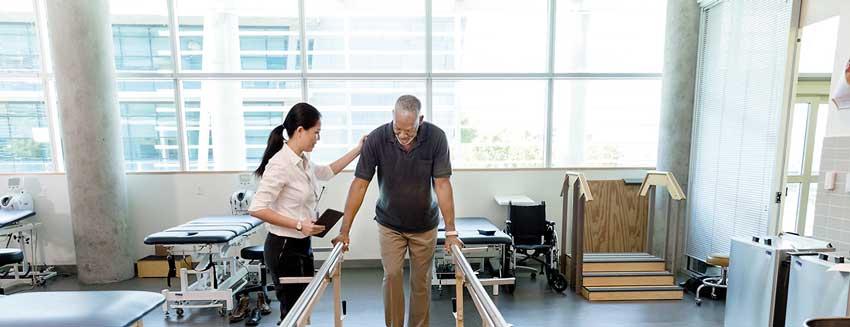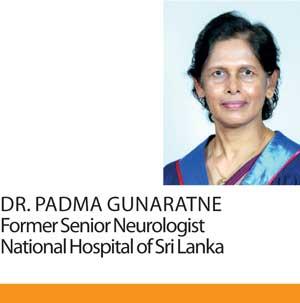11 Sep 2020 - {{hitsCtrl.values.hits}}


Stroke happens all of a sudden. It turns your world upside down. Following a stroke there are few challenges one might have to face with. Stroke could affect one’s physical, mental and social well-being. Stroke can be beatable. Rehabilitation is the key to achieving and celebrating all the small victories along your way to recovery.
According to Former Senior Neurologist in National Hospital of Sri Lanka, Dr. Padma Gunaratne, Strokes could lead to many disabilities such as vision impairment, speech impairment, cognitive impairment, weakness in limbs, etc. All these disabilities would vary in each case from patient to patient. “Stoke is not a rare phenomenon. About one in hundred in Sri Lankan community has had a stroke,” Dr. Gunaratne explained.
Challenges faced due to disabilities
While physical disability is the most common impairment following a stroke, the exact nature of one’s disabilities after the first stroke varies widely. For an example, a patient could suffer from a vision impairment where he lost one side of his field of vision or may have difficulty in determining the distance between objects or depth perception. Or it could be speech impairment in relation to articulation of words, understanding of speech or a problem of expression. It could be a cognitive impairment affecting the psychological wellbeing. These disabilities fall on a very broad range.
“A person who was in perfect health, all of a sudden from the time he experienced the first stroke, might have difficulty in doing many things he did previously,” Dr. Gunaratne said. For an example a driver after experiencing the first stroke could no longer be able to drive due to a vision impairment caused as a consequence of the stroke. He would lose his job. Strokes would affect a patient’s ability to carry out simple functions such as simple calculations.
These disabilities could severely affect one’s psychological wellbeing. Dr. Gunaratne said it could lead to anxiety and depression among the patients. They may have difficulty in returning to their day-to-day life as they couldn’t be independent as they were once before.
Diet and Exercise
Dr. Gunaratne stated that 95% of strokes happen due to the condition called Atherosclerosis or thickening of blood vessels. In this context, it refers to the buildup of fats, cholesterol and other substances in and on your artery walls, which can restrict blood flow to your brain. There are many risk factors that cause the development of atherosclerosis based on one’s lifestyle habits. After a stroke one should be mindful about their diet to prevent another stroke from happening.
The diet that should be followed differs from patient to patient. It depends on whether the patient is overweight, obese, diabetic, etc. “But in general, they have to consume less deep fried food, red meat, starch and sugar and eat more fruits and vegetables,” she said. They should reduce salt intake as well. In addition, Dr. Gunaratne said after the first stroke, patients should immediately cease smoking and limit their alcohol consumption. In her expert opinion, it is important to follow a proper dietary plan to avoid high blood pressure, diabetes, high cholesterol, etc.
“When it comes to exercise, the amount of exercise that a patient should be engaged in depends on his/her condition. If he/she is medically stable, one can start exercise after the first 48 hours,” Dr. Gunaratne explained.
The type of exercise possible would depend on one’s disabilities as well. “But in general, regardless of the type of exercise, one must start at a lower level and should gradually build up over time and should engage regularly,” Dr. Gunaratne commented. As stroke patients could easily fall prey to heart attacks, she encouraged patients with heart disease to discuss with their physicians before engaging in any sort of exercise regime.
Advice for the caretakers
Dr. Gunaratne believes that the most vital aspect of taking care of stroke patients is understanding the disabilities and challenges faced due to such disabilities. All the time the caretaker has to have knowledge on stroke and the disabilities of the person. “For an example, there are patients who lost vision in half of the field. When he eats a plate of rice, he might eat only one half, the half he sees. When you keep a glass of water for him, it’s important that you keep it in the patient’s field of vision. If it’s kept on the half that he does not see, the patient will not see it and may knock the glass over,” she explained.
The caretakers should have patience, empathy and should be committed. Also they should have a clear understanding of the medications prescribed to the patient and the importance of the patient taking the medications as advised by the physicians.
“Moreover, they should understand the limitations of rehabilitation. If a person suffered from a severe stroke, he may never gain full control of his limbs even through physiotherapy. In those patients, our primary objective is not to make the affected limb of the patient normal but the patient to be made independent where he could perform the tasks he performed previously, by different means if needed,” Dr. Gunaratne commented. “It’s so rewarding to give care to stroke patients because in contrast to many conditions, stroke patients improve day by day,” Dr. Gunaratne concluded.
21 Dec 2024 14 minute ago
21 Dec 2024 6 hours ago
21 Dec 2024 8 hours ago
21 Dec 2024 21 Dec 2024
21 Dec 2024 21 Dec 2024